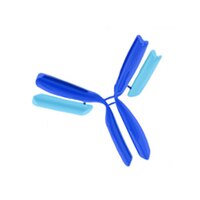Neto auxiliary protein interactions regulate kainate and NMDA receptor subunit localization at mossy fiber-CA3 pyramidal cell synapses.
Wyeth, MS; Pelkey, KA; Petralia, RS; Salter, MW; McInnes, RR; McBain, CJ
The Journal of neuroscience : the official journal of the Society for Neuroscience
34
622-8
2014
Show Abstract
Neto1 and Neto2 auxiliary subunits coassemble with NMDA receptors (NMDARs) and kainate receptors (KARs) to modulate their function. In the hippocampus, Neto1 enhances the amplitude and prolongs the kinetics of KAR-mediated currents at mossy fiber (MF)-CA3 pyramidal cell synapses. However, whether Neto1 trafficks KARs to synapses or simply alters channel properties is unresolved. Therefore, postembedding electron microscopy was performed to investigate the localization of GluK2/3 subunits at MF-CA3 synapses in Neto-null mice. Postsynaptic GluK2/3 Immunogold labeling was substantially reduced in Neto-null mice compared with wild types. Moreover, spontaneous KAR-mediated synaptic currents and metabotropic KAR signaling were absent in CA3 pyramidal cells of Neto-null mice. A similar loss of ionotropic and metabotropic KAR function was observed in Neto1, but not Neto2, single knock-out mice, specifically implicating Neto1 in regulating CA3 pyramidal cell KAR localization and function. Additional controversy pertains to the role of Neto proteins in modulating synaptic NMDARs. While Immunogold labeling for GluN2A at MF-CA3 synapses was comparable between wild-type and Neto-null mice, labeling for postsynaptic GluN2B was robustly increased in Neto-null mice. Accordingly, NMDAR-mediated currents at MF-CA3 synapses exhibited increased sensitivity to a GluN2B-selective antagonist in Neto1 knockouts relative to wild types. Thus, despite preservation of the overall MF-CA3 synaptic NMDAR-mediated current, loss of Neto1 alters NMDAR subunit composition. These results confirm that Neto protein interactions regulate synaptic localization of KAR and NMDAR subunits at MF-CA3 synapses, with implications for both ionotropic and metabotropic glutamatergic recruitment of the CA3 network. | | 24403160
 |
Kainate receptor post-translational modifications differentially regulate association with 4.1N to control activity-dependent receptor endocytosis.
Copits, BA; Swanson, GT
The Journal of biological chemistry
288
8952-65
2013
Show Abstract
Kainate receptors exhibit a highly compartmentalized distribution within the brain; however, the molecular and cellular mechanisms that coordinate their expression at neuronal sites of action are poorly characterized. Here we report that the GluK1 and GluK2 kainate receptor subunits interact with the spectrin-actin binding scaffolding protein 4.1N through a membrane-proximal domain in the C-terminal tail. We found that this interaction is important for the forward trafficking of GluK2a receptors, their distribution in the neuronal plasma membrane, and regulation of receptor endocytosis. The association between GluK2a receptors and 4.1N was regulated by both palmitoylation and protein kinase C (PKC) phosphorylation of the receptor subunit. Palmitoylation of the GluK2a subunit promoted 4.1N association, and palmitoylation-deficient receptors exhibited reduced neuronal surface expression and compromised endocytosis. Conversely, PKC activation decreased 4.1N interaction with GluK2/3-containing kainate receptors in acute brain slices, an effect that was reversed after inhibition of PKC. Our data and previous studies therefore demonstrate that these two post-translational modifications have opposing effects on 4.1N association with GluK2 kainate and GluA1 AMPA receptors. The convergence of the signaling pathways regulating 4.1N protein association could thus result in the selective removal of AMPA receptors from the plasma membrane while simultaneously promoting the insertion and stabilization of kainate receptors, which may be important for tuning neuronal excitability and synaptic plasticity. | Immunofluorescence | 23400781
 |
Mapping the Ligand Binding Sites of Kainate Receptors: Molecular Determinants of Subunit-Selective Binding of the Antagonist [3H]UBP310.
Atlason PT, Scholefield CL, Eaves RJ, Mayo-Martin MB, Jane DE, Molnár E
Mol Pharmacol
78
1036-45. Epub 2010 Sep 13.
2010
Show Abstract
Kainate receptors (KARs) modulate synaptic transmission and plasticity, and their dysfunction has been linked to several disease states such as epilepsy and chronic pain. KARs are tetramers formed from five different subunits. GluK1-3 are low affinity kainate binding subunits, whereas GluK4/5 bind kainate with high affinity. A number of these subunits can be present in any given cell type, and different combinations of subunits confer different properties to KARs. Here we report the characterization of a new GluK1 subunit-selective radiolabeled antagonist (S)-1-(2-amino-2-carboxyethyl)-3-(2-carboxythiophene-3-yl-methyl)-5-methylpyrimidine-2,4-dione ([(3)H]UBP310) using human recombinant KARs. [(3)H]UBP310 binds to GluK1 with low nanomolar affinity (K(D) = 21 ± 7 nM) but shows no specific binding to GluK2. However, [(3)H]UBP310 also binds to GluK3 (K(D) = 0.65 ± 0.19 μM) but with ∼30-fold lower affinity than that observed for GluK1. Competition [(3)H]UBP310 binding experiments on GluK1 revealed the same rank order of affinity of known GluK1-selective ligands as reported previously in functional assays. Nonconserved residues in GluK1-3 adjudged in modeling studies to be important in determining the GluK1 selectivity of UBP310 were point-mutated to switch residues between subunits. None of the mutations altered the expression or trafficking of KAR subunits. Whereas GluK1-T503A mutation diminished [(3)H]UBP310 binding, GluK2-A487T mutation rescued it. Likewise, whereas GluK1-N705S/S706N mutation decreased, GluK3-N691S mutation increased [(3)H]UBP310 binding activity. These data show that Ala487 in GluK2 and Asn691 in GluK3 are important determinants in reducing the affinity of UBP310 for these subunits. Insights from these modeling and point mutation studies will aid the development of new subunit-selective KAR antagonists. | | 20837679
 |
Evidence for a role of glutamate as an efferent transmitter in taste buds.
Vandenbeuch A, Tizzano M, Anderson CB, Stone LM, Goldberg D, Kinnamon SC
BMC Neurosci
11
77.
2010
Show Abstract
BACKGROUND: Glutamate has been proposed as a transmitter in the peripheral taste system in addition to its well-documented role as an umami taste stimulus. Evidence for a role as a transmitter includes the presence of ionotropic glutamate receptors in nerve fibers and taste cells, as well as the expression of the glutamate transporter GLAST in Type I taste cells. However, the source and targets of glutamate in lingual tissue are unclear. In the present study, we used molecular, physiological and immunohistochemical methods to investigate the origin of glutamate as well as the targeted receptors in taste buds. Full Text Article | | 20565975
 |
















